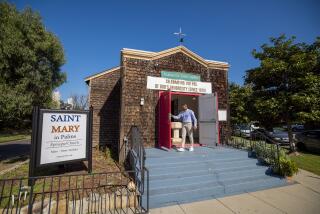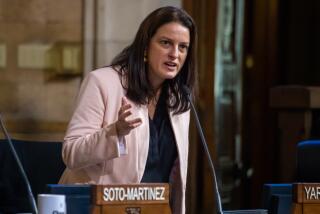System for Loans Takes Page From the Jewish Past
In the 1880s, when few U.S. banks would loan to Jewish immigrants, leaders of that community found their own way to finance the American Dream: They created lending institutions to help tailors, pushcart merchants and candy shop owners.
Now a local Jewish organization is following in that tradition with the creation of a faith-based fund that will accept loans from Jewish individuals and institutions and redistribute them to low- and moderate-income communities. The loans will be used for affordable housing, small businesses and community facilities.
“We have in our recent history this memory of what it was like to come over to this country and not have access to the mainstream economy,” said Celia Bernstein, West Coast director of The Shefa Fund, which is based in Santa Monica. “This is what creates the passion for this endeavor.”
At a news conference held at a home in the Crenshaw district today, organizers will celebrate the first round of loans from the revolving fund that now stands at $500,000. In the Los Angeles area, the goal is to organize $1 million each year to be used for community investment, Bernstein said.
In Hebrew shefa means abundance. The Shefa Fund, a public foundation, was created in 1988 in Philadelphia with the goal, as the organization puts it, of helping American Jews “use their abundance to repair the world.”
Shefa and its new local fund--the Los Angeles TZEDEC Initiative -- and its religious appeal are a welcome addition to those trying to bring about change, said Douglas Bystry, president of Clearinghouse CDFI, which will receive loans from the fund. The initiative’s name is based on tzedek, which means justice.
“The whole concept of giving from their abundance is important in the work we do,” said Bystry.
“It’s a way to take these funds of individuals and make sure they get into the community to do good works. We’re very excited about it.”
The Shefa Fund acts as a bridge between the Jewish community and those institutions that lend to nontraditional borrowers; individuals or community groups that often are unable to access capital through mainstream banks.
Shefa encourages Jewish individuals or institutions to loan money to the Shefa Fund for 3-, 5- or 7-year terms at no or 1% interest. Shefa then loans the funds to community development financial institutions. Such lenders provide capital and financial services to underserved communities.
In Los Angeles the Shefa Fund will loan to Broadway Federal Bank, Los Angeles Neighborhood Housing Services, and Clearinghouse CDFI, which will then make loans directly to homeowners, entrepreneurs or community groups.
Los Angeles Neighborhood Services will re-lend the money to families of modest means, those whose incomes are 80% of the median income for the area or less. The loans will be used to help with down payments, closing costs and home improvements and to assist those who have been victimized by predatory lending.
“So many people can’t afford to purchase anything right now because there’s such a limited supply,” said Jo-An Turman of Los Angeles Neighborhood Housing Services. “It’s always great to see some additional funds be filtered to underserved communities, especially those we have been focusing on for the past 20 years.”
Clearinghouse CDFI will make loans to community-based organizations for housing or facilities like child-care centers.
“We deliberately are partnering with lenders who have ... the trust and confidence of the communities we’re trying to impact,” Bernstein said.
Typically the money in the fund comes from individuals and institutions who will need it in the future but not immediately, Bernstein said.
More important than the monetary return is the satisfaction of knowing that the funds can help revitalize lives and communities.
That idea, said Bernstein, is rooted in Jewish tradition.
The scholar Maimonides “basically wrote out a ladder of righteous giving from the highest degree to the lowest degree,” she said. “The highest is to enter into a partnership or a loan with a poor person in order to lift themselves out of poverty.... Community development investment is really the most effective use of your dollars. Why? Because the effects are quantifiable.”
More to Read
Sign up for Essential California
The most important California stories and recommendations in your inbox every morning.
You may occasionally receive promotional content from the Los Angeles Times.










